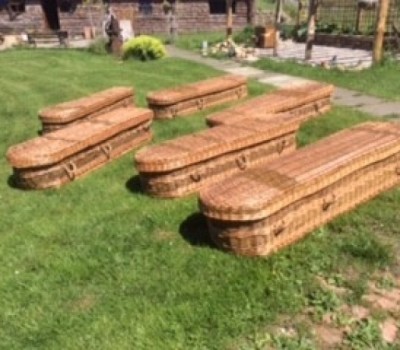Featured News
October Meeting Eden Valley Basketry Group
03 November 2025
Additions to the What's On section of the website02 November 2025
Categories
- Hepple
- General
- Etal
- Lucker
- Whitley Chapel
- Borders
- Weardale
- Cullercoats
- Tees Valley
- Broadrake
- Eden Valley
Join our Mailing List
Receive the latest news direct to your inbox by signing up below :
Coffin Workshop
Why run a coffin workshop? Willow coffins tick all the boxes, aesthetically pleasing sustainable materials, low carbon footprint on delivery miles within the UK, all-round environmentally friendly, particularly so if lined with felted wool. Even better for reduced carbon footprint is a willow body tray with felted shroud, but some find that all too minimalist. Of those attending all were capable basket makers, intensely keen to promote something likely to reduce climate change. Only one was definitely making the coffin for themselves, others came from needing to diversify their willow work as some income strands have frozen, or wanting a means to start talking about death.
Thursday, May 14th should have been the last day of a 4-day coffin workshop with Naturally Useful's Karen Collins. As events unfolded, it was put off until late June by which time lockdown restrictions had eased considerably. Some 10 days before the start, our venue cancelled. Lucky for us, a member offered her large barn, near Wingates, as I scrambled to keep the workshop on track. Coffin making is deemed essential work, so training a small group of makers would be permissible and the final venue was sufficiently large to allow us to follow the government guidelines and proceed.
Let me say we had a very good four hot days, with very credible coffins the result. As with making most baskets, there were several ways to achieve the required result, which as well as satisfying the maker and purchaser aesthetically must meet the exacting and particularly standards of a UK crematorium. There are charts re depth, width, height permutations from both crematoriums and undertakers, mine was 6 feet long, 13 inches wide at the base, 20 inches wide somewhere between bosom and shoulder, teardrop style, others made parallel-sided ones, to use in the interim, as storage boxes, Most came in at 13 inches deep. We made hurdle style bases and lids, with uprights tied on as for scalloms without the pairing down. The base sticks were sawn larch slaths, those for the lid bamboo canes. Needless to say, there is an awful lot of weaving in a coffin, but by 2.45 on Thursday afternoon we got there (mine did need a lot of picking off, plus the tweaking of one or two wayward rods the next day).
Thank you for the NBG grant it was enormously important to achieving the successful workshop, supporting participants and contributing to the extra costs around separate accommodation, tutor meals and other domestic add ons.
A coffin made by one student will be used for a funeral in early July.
Author Details
Author Name: Charlotte BoxallPublish Date: 30th June 2020

